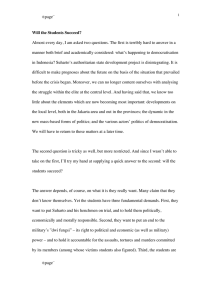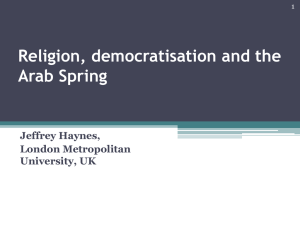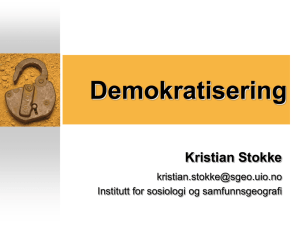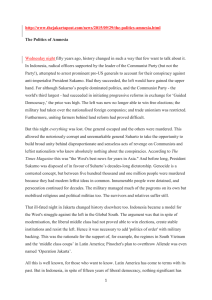“Democratisation in East Asia” Shaun Breslin CSGR Working Paper No. 100/02
advertisement
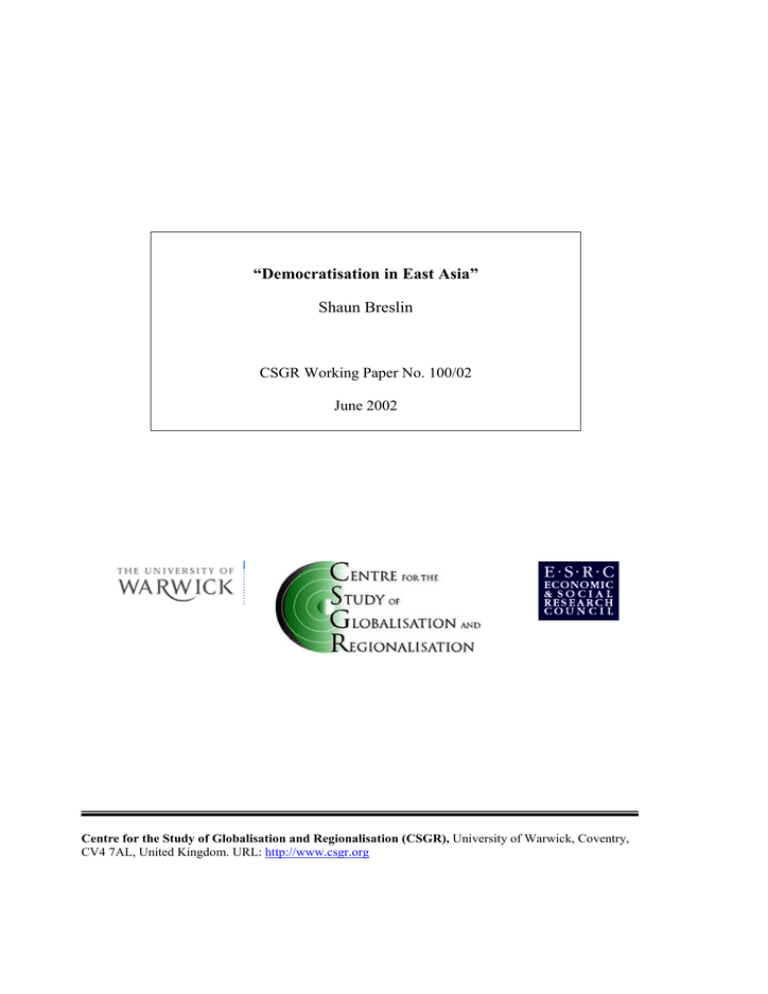
“Democratisation in East Asia” Shaun Breslin CSGR Working Paper No. 100/02 June 2002 Centre for the Study of Globalisation and Regionalisation (CSGR), University of Warwick, Coventry, CV4 7AL, United Kingdom. URL: http://www.csgr.org Democratisation in East Asia Shaun Breslin University of Warwick CSGR Working Paper No 100/02 June 2002 Abstract This paper considers how an assessment of East Asian states helps us test concepts of democratisation. It argues that many of the analytical approaches deployed by democratisation scholars reflect the contexts in which the majority of democratisation studies have been developed. In particular, they underplay the significance of the lack of separation of state and economy – of public and private – that predominates in much of the developing world. It argues that democratisation studies can be enhanced by engaging with the insights provided by international political economy approaches – particularly, but not only, in relation to the study of East Asia. This working paper is a chapter from the forthcoming book Democratization Through the Looking Glass, edited by Peter Burnell, for publication by Manchester University Press in 2003. The book contains different perspectives of several disciplines such as international political economy, legal scholarship, sociology and women’s studies, together with the insights of different area studies. It advances the case for a broadly based comparative study of democratisation, while arguing that multidisciplinarity will enhance our understanding far more than a narrow political science approach. Keywords: Democratisation; East Asia, international political economy Address for correspondence: Dr Shaun Breslin Centre for the Study of Globalisation and Regionalisation University of Warwick Coventry, CV4 7AL, UK Email: shaun.Breslin@warwick.ac.uk The task of writing about democratisation in East Asia as a whole is a hugely problematic one. It is a region that contains massive diversity in political and economic systems and one that remains in a state of considerable flux and transition. A key element in this transition is the end of the cold war, and the resulting reduction in US tolerance of authoritarianism so long as that authoritarianism was overtly anti-communist in nature. It is also a region where, like in East and Central Europe, communist party states are struggling with the transition from centrally planned socialist economies – though in comparison to the European case, and with the exception of Outer Mongolia, this is a transition that has not been accompanied by the end of communist party rule and a parallel process of democratic transition. And it is also a region where financial crises and economic recession have dominated political activity and discourse for half a decade. Perhaps more than any other region considered in this volume, the overarching framework for political activity in the region is shaped by the transition from cold war strategic structures to globalised economic structures. A quick analysis of the Freedom House indexes for regional states gives some indication of the problems of considering the region as a whole1. At one extreme we have the established democracy of Japan – though even here, the transition from managed factionalism within the structure of LDP rule to conflictual factionalism and political fragmentation in the post LDP coalition governments has created new challenges to democratic politics. There is then a second set of states which have seen considerable moves towards democratisation – in South Korea where military rule has given way to a political system where transfers of power via the ballot box are now an accepted part and parcel of political life; in Outer Mongolia which has moved from 7,7 to 2,3 “free” as a result of the end of communist party rule and the election of the Democratic Union Coalition in 1996; in Indonesia, which whilst still only partially free and retaining considerable authoritarianism has nevertheless moved from 7,6 in the mid-1990s to 4,4, partially free today; and in the Philippines and Thailand which have moved from partially free to free; and perhaps most notably in Taiwan, which has witnessed the end of martial law and the transition from Guomindang single party rule to the presidency of the DPPs Chen Shui-bian in just over a decade. But before we proclaim the end of history and applaud the transition to democracy, we should consider three other sets of states in the region. At the other extreme to Japan, we have the rigidly authoritarian states of Burma and North Korea, which remain, perhaps more than any other states in the world, as impervious to the international system as can be today. A second set of authoritarian states is found in the residual communist party states of Laos, Vietnam and China, where political and social freedom remained strictly restrained despite increased economic freedom as a result of marketisation and the retreat from socialism. A third set, on its own, is Singapore, where the electoral system should not be allowed to disguise a limited franchise, and strict state controls over social freedom. Finally, there is a set of regional states which have moved away from freedom and democratisation. For example, Cambodia, which has tightened authoritarian rule despite partial freedom status in the mid-1990s; in Malaysia which has moved from 2,3 free in 1972 to 5,5 partially free today. We should perhaps also include in this set of states Hong Kong, which while never having a full and free franchise, has seen even limited democratisation circumscribed by the reversion to Chinese sovereignty in 1997. There has been no single wave of democratisation in Asia then. Though it is possible to draw comparisons from the similar processes in the transition from military rule in South Korea and Taiwan (Wu, 1998; Potter 1996) - which have both occurred in the context of relations with the US and relations with rival regimes to the north - discerning region wide patterns is not so much problematic as impossible. It is possible, of course, to provide in a chapter of this sort a short potted tour of democratisation (and the lack of it) in each regional state – but that would be unsatisfactory to. As such, this chapter seeks to draw out conceptual and methodological issues in considering democratisation in Asia – issues that will vary in importance and relevance in each regional state. At its heart is a concern with avoiding concept stretching – to avoid the pitfall of seeing something that is familiar to democratisation and assuming that it functions in the same way in Asia (and indeed in other areas of the world) as it does in the west. Asian Values and the Politics of Rejection: What Asia Isn’t A concept of a clear notion of what East Asia means in terms of studies of democratisation in large part emerges from the “Asian Values” debate, which in itself has been spurred by Huntingdon’s (1996) notion of a “clash of civilisations”. The idea that there are a set of Asian values that are effectively different from western traditions has some attraction – attraction in the west as it makes Asia easier to bracket as “different” and attraction in some parts of Asia at least as it provides a partial justification for the authoritarian nature of many Asian regimes, and the absence of human rights in others. The argument for a concept of Asian Values can be simplified into a very straightforward manner. Asian societies, it is argued, have developed on a very different trajectory from those in the West, and have different philosophical and/or historical cultural roots. In the west, the emergence of democracy and notions of rights were largely devised to provide a bulwark for the individual from the state. And democracy, as practiced in the West, now takes place in the context of post-industrialised societies with well established procedures and norms for the conduct of political life (Lee 1994). In Asia, by contrast, the roots of the contemporary system are very different. For example, the traditional Confucian concept of society (that predominated in China, Korea and to a lesser extent, Japan) was one based on harmony and unity between state and people – the idea of creating a bulwark against the state was anathema as state and society should be one. Where a discourse on rights existed, it was largely conducted in terms of collective rights, where the interests of the collective – be that collective the family, the state, or even socialism – were far more important than those of any individual (Weatherley 1999). In considering a truly comparative study of democratisation, there should be sympathy for the understanding that democracy and democratisation are culturally, historically and politically embedded. But the idea that there is a single set of “Asian Values” that provides a lens through which we study democracy in East Asia should be considered with considerable scepticism. In some respects, the concept helps our understanding by establishing a notion of the “other” in which Asian debates over democracy take place. The concept of Asia that the Asian Values debate promotes is a rejectionist one – what is shared is a rejection of the imposition of what is considered to be a “western” concept of politics and polity that have developed and emerged in specific western contexts that are not applicable to Asia. This understanding is also reflected in other realms of politics – for example, a rejection of the neo-liberal “western” economic policies as embodied in the policies of the IMF and the WTO, and a rejection by some of the post-industrialised and unfair environmental strategies pursued by many Western states. This rejectionist stance is perhaps best embodied by attempts to create a cognitive understanding of a region called “East Asia”. This understanding is largely predicated on a rejection of the Asia Pacific Economic Cooperation (APEC) definition of a region which includes not only the Asian states of Asia, but also the AustralAsian states, and those states on the Pacific sea-board of the Americas. The proposals of the then Malaysian premier Mohammed Mahathir to establish an East Asian Economic grouping (now formally the East Asian Economic Caucus within APEC) is a good example of defining a region by what it is not (Higgott and Stubbs 1995). So too was the impulse to decide on an Asian entity that would negotiate with the European Union in the Asia Europe Meeting (ASEM) process, which perhaps for the first time forced “Asia” to decide what it was – and in the process, it rejected both the Indian sub-continent and Australasia as constituting Asia (Higgott 1999). So what the Asian values debate helps clarify is what Asia is not – it is not the advanced industrialised democratised West. It is also framed by a world view in many Asian governmental elites which is suspicious of the motives of the West in trying to condition developments in the region. And in many cases, the West is synonymous with the United States, and for many regional critics of globalisation, it is nothing more than Americanisation. But while it might help us understand what Asia is not – what it rejects - it does not help us understand what Asia is. On one level, the concept that there is a single set of Asian values that spans the entire region obfuscates more than it clarifies. At worst, it lends towards an assessment of democratisation in the region that treats it as a single entity, rather than reflecting the immense diversity that exists. On another level, the search for explanations in traditional Asian values can be rather problematic. For example, in searching for the roots of liberal thoughts in Confucianism, Goldman (1994) concludes that the basic tenets of Confucianism are not necessarily congruent with concepts of Human Rights. This may indeed be true, and Sen (1997) has argued forcefully against the Asian Values concept as a justification for authoritarianism. But in some respects, searching for the roots of contemporary authoritarianism or contemporary democracy in The Analects is akin to searching for the roots of democracy in the UK in the belief systems of the druids. In the intervening years, the structure of state power in China and in other states has done much to shape the way in which traditional ideas have become transformed into contemporary state systems. So rather than emphasise too strongly the historical philosophical roots of contemporary policy and intellectual discourse, I instead emphasise other factors that should inform the way in which we study contemporary democratisation in East Asia, and which in turn, might help us understand some of the preconditions upon which studies of democratisation in the west are constructed. The Comparative Method and Democratisation First, we should simply not ignore the fact that comparative analyses need to take care when they decide on the unit of comparison. If we take democracy in the West as our benchmark, then there might be a simple tendency to compare other parts of the world now with democracy in the West now. I suggest that this can lead to a false set of comparisons, and we should rather consider the correct temporal comparison. The emergence of democracy in the West was a slow and protracted evolutionary process. As too was the Western industrial revolution. Analyses of democratisation and human rights in, for example, the UK during the industrial revolution would not necessarily generate favourable comparisons with the situation in the UK today. As such, as the focus of this book correctly requests, we should consider comparison between comparable processes of democratisation as a process, and accept that the experience in the West at similar phases of the national and industrial revolutions might generate a sounder foundation for comparison than judging unlike with unlike within an arbitrarily chosen common temporal framework. We have noted above the disparities that exist with Asia itself - from the relatively liberal political and economic system of Japan at the one extreme to the authoritarian (by any comparison) Burmese system at the other. If we knock out the most “advanced” industrialised economies of Japan, Korea and Taiwan, and ignore the rather strange anomalies of the city states of Singapore and Hong Kong, then we are left with a situation where three key transitions have yet to take place in much of Asia – economic revolution, national revolution and a polanyiesque great transformation2. First, we need to recognise that economic underdevelopment remains the major context for politics in much of the region. We need to take care not to be too heavily influenced by the growth rates recorded by many Asian states in the last two decades – if you produce one tractor one year, and two the next, you may have a growth rate of 100 per cent, but you still only have three tractors. For example, despite near double digit growth rates in China for two decades, and the fact that the sheer size of the country generates an enormous gross level of GDP, per capita GDP in China is still less than in Russia, which is largely considered to be the negative comparison in terms of economic fortunes in the transition from socialism. And of course, in 1997, the Asian financial crises placed a new dimension on this issue of economic development. On one level, the crises promoted the importance of democratisation, in terms of a reaction against the “crony capitalism” that some argued had at least contributed to the crises (Wei and Dievers 2000; Lian 2002). Crises and economic recession in many regional states impacted on the newly expanded middle classes who had been beneficiaries of the pre-crises boom. It is within these groups that many of the pressures for change now emanate in Thailand, Indonesia and Malaysia. Similar pressures from the middle class can also be observed in Hong Kong, where the educated middle classes are feeling the impact of economic recession for the first time in generations. Business elites too have been forced to rethink their position and their relationship with the state as a result of the crises – indeed, in Thailand, a representative of the business elite was elected to lead the country. Rather than allow politicians to run the country on their behalf, the Thai elites appear to have decided to run I themselves ! There have also been uncertain or ambivalent consequences of crisis. Hewison (2001) notes that in Thailand, there has been a turn towards local identities and localism as a response to national crisis. Such localism could provide the basis for a more participatory democratisation at the grass roots level. But it is also predicated on a concern that Thai culture is under attack from the agencies of international capitalism in the shape of World Bank and IMF recovery projects – projects that “impose” alien Western values and practices. In this respect, nationalism as a response to crises has been an important political change in three main ways as state elites have tried to turn the blame for crises away from themselves and on to “outside” groups. First, the blame for the crises has been placed on foreign banks and investors who moved their portfolios out of the region at speed triggering financial chaos. Second, with the support of state elites, it has reinforced the rejectionist stance towards the West detailed above. Third, and again with the support of state elites, most notably in Indonesia, it generated a wave of ethnic violence against minority groups – particularly the overseas Chinese. As outside observers, it is easy to point to the role of the state in attempting to deflect criticism for their own actions or inactions – and to an extent this is a valid argument. But we should not simply ignore the real concerns of many within the region. Real concerns on one level that the West is imposing its values on countries with different historical, philosophical, cultural and political roots. But also real concerns that this thing called globalisation is really impinging on sovereignty. What point is there in voting for one party or another if the fundamental economic strategy of whichever government is elected is shaped by the IMF and the World Bank, or by the investment and disinvestments strategies of major external corporations and investment brokers? In this respect, there is a real feeling of disempowerment amongst many in the region, and a concern that globalisation has resulted in a “democratic deficit” – particularly amongst many in the intellectual community as perhaps best articulated by the work produced by Bello, Bullard, Guttal and others via the “Focus on the Global South”3. Finally, the crises have impacted hardest on rural farmers and the urban working classes – many of whom are now the urban unemployed. These groups are the least represented in democratic politics, in terms of both formal political parties and organisations, and in terms of participation in pressure groups, and civil society organisations. While they were perhaps never particularly well represented in many regional states, there under-representation now at a time when they need it more than ever is an important consideration in democratic politics. Of course, it is entirely right and justifiable to consider the growth of civil society as an indicator of democratisation and progress. But in doing so, we should not ignore the issue of the balance of representation and the extent to which democratisation permeates all sectors of society. I suggest, then, that much of the activity of civil society in the region represents the interests of the middle classes – perhaps even over-represents those interests, whilst business elites retain an even stronger access to the political process and the representation of interest. A key challenge that remains is to ensure that democracy becomes more inclusive, more participatory, and more representative of the interests of those who may not be formally disenfranchised, but are often largely excluded from the political process. We should remember that the national revolution in many Asian states is incomplete. Or at the very least, the process of nation building and state consolidation in many Asian states is still ongoing. The concept of a Vietnamese nation, for example, is still relatively new by historical comparison, and largely a consequence of the dual processes of colonisation and decolonisation. Indonesia, as a political entity, has been challenged by the secession of East Timor, raising the fear in some (and hope in others) that the Indonesian state may further fragment into ethnically defined nation states. And in Korea and China, we still have the spectre of rival regimes claiming (though not always reciprocally) jurisdiction over a disputed national entity. Without a clear understanding of what constitutes the demos, then constructing democracy is inherently problematic. This immature concept of nationhood and statehood is often explained in terms of the end of the cold war. And indeed, the end of the cold war has played a key role. But in many respects, these issues are pre-cold war in nature and owe much to the incomplete process of decolonisation and nation building that the onset of the cold war interrupted. Ethnic tensions, that are often closely related to this incomplete national revolution, also impinge on the evolution of democracy in many states. We have already noted above the ethnic tensions that emerged during the financial crises, most notably in Indonesia. But even in more peaceful “normal” times, resentment at the control of political power by dominant ethnic groups in Malaysia, Singapore and Indonesia to name but three regional states undermine the legitimacy of the democratic polity. But perhaps most fundamentally, we need to return to the way in which we study democratisation and the basic premises on which many analyses are made. As a starting point here, we return to the classic text by Polanyi (1944). Almost implicitly, many studies of democratisation take the “great transformation” as a given. The separation of public and private, of state and market, that occurred in Europe and other industrialised democracies established the basis of an understanding of the relationship between the state and non-state in which conceptions of democratisation largely exist. In particular, when moving beyond an over simple equation of elections with democracy, this separation of public and private is an essential component for understanding the state-society relationship. But in reality, it was the “great transformation” of industrialisation in Europe in the nineteenth century that marks the “singular departure” from the dominant norm by creating the institutional separation of society into an economic and political sphere. For vast parts of the world – not just in Asia – this transformation has not taken place, or is at best incomplete. The most obvious examples of this lack of separation are found in the communist party states within the region, where the socialist system all but demanded state control over society and economy. But it is also evident in other states – states which at first glance appear to be western type democracies. Van Wolferen (1990), for example, has long argued that analysts from the “west” fail to understand Japan because they start with false assumptions. The concept of a separation between “public” and “private” that lies at the heart of some investigations of political economy is, according to van Wolferen, absent in Japan. For Deans (1997), this is a consequence both of “both the traditional understanding of ‘economy’ in East Asia and the way in which market economies were established there”. In Taiwan, where the residual authoritarian Guomindang government has been replaced through democratic elections, the former holders of a monopoly on state power retain strong control over key economic functions through their ownership of large sections of the means of production. Should this concern us as students of democratisation, or is it an issue that we should leave for the political economists ? Perhaps the details of state control and influence over the economy are best left for discussion elsewhere. However, I contend that analytical divisions between the national and the international, and between the political and the economic, obstruct a more nuanced understanding of domestic political processes and their impact on democratisation in the contemporary world. As Gamble et al (1996: 10) argue: “The separation between the global and the local no longer holds, as the new hierarchies of the global economy cut across regional and national boundaries” As such, I argue that a key, and neglected area of study in analyses of democratisation, is the ability for the demos to influence, through political processes, economic policy making which impinges on the lives of national citizens – either through the structure of domestic political economies, or through the influence of external “international” factors. In particular, a key issue here is the ability of those outside a narrow section of state elites and their allies to influence policy through democratic means, and the related question of transparency. Robison (1988), for example, takes issue with analyses that claim that the Indonesian system does not work effectively. The point Robison wants to drive home is that political systems are designed to serve specific political interests. The Indonesian system might not have worked as external observers thought it should, but was in fact very successful in delivering the fruits of economic growth to members of the Indonesian elite. In particular, the politico-economic system was constructed to ensure that the Suharto family utilised political power to advance their economic status and control. The Indonesian system, then, was deliberately opaque, and constructed to ensure that an elite group of insiders utilised a linkage between political power, economic policy making, and state or family control over major sectors of the economy, to deliver rewards to themselves. Lasswell’s (1936) question, “who gets what ?” is still a pretty good starting point for considerations of how political leaders make policies designed to benefit specific interests. Perhaps Indonesia is an extreme case, though one which is remarkably similar in its deliberate opaqueness to the one that is emerging in China, as the transition from socialism creates a similar close relationship between elite policy makers, and the beneficiaries of those policies (many of whom emerge from within the party-state system itself). However, even in the most “liberal” – in that it looks like a western democratic system – democracy in the region in Japan, an understanding of the functioning of the domestic political economy raises a number of questions over the validity of deploying “traditional” understandings of democratisation. It is helpful here to consider the conceptions of a “capitalist developmental state” (CDS). The CDS system proved to be remarkably successful in generating economic growth in Japan and the NICS – policies which were partially emulated by later generations of developing states in the region. For Chalmers Johnson, a key component in this developmental strategy was “relative state autonomy” of elite bureaucrats who planned economic strategy (albeit in market conforming manners) around perceived national interests - politicians reign but bureaucrats rule (Johnson 1987: 152). What this means is that irrespective of the result of democratic elections, an elite group of professional bureaucrats made economic policy based on their conceptions of the national interest unconstrained by considerations of electoral popularity, and insulated from the demands of societal interest groups. The politicians could worry about getting re-elected – in the Japanese case, by considering the interests of their local constituency rather than issues of wider national importance – and the bureaucrats would get on with running the economy. Thus, electors might be able to influence local developmental issues through the democratic process – to win a new train link with Tokyo or a new road – but the overall direction of national economic planning continued unhindered by the inconvenience of democratic politics. This system was facilitated by the eradication of powerful interest groups at the end of the second world war – through first defeat and then US occupation in Japan which resulted in the suppression of business and then workers’ interests. Through Japanese occupation in Korea which resulted in weak societal or interest groups in the new South Korea. And through the elimination of local interests in Taiwan with the arrival of the Guomindang, and the resulting party-state control of society and economy. In all three cases, the state was emboldened by proclaimed strategies of national renewal, and national mobilisation to defend these new statist entities in the face of possible communist aggression in the region (Cumings 1987). And we should remember that in this cold war context, being authoritarian, but anticommunist authoritarian, was often enough to receive considerable US economic aid, and western tolerance of the lack of democratic forms. In the case of Japan, the national interest was defined, according to Johnson (1981), by a policy community that encompassed a triad of bureaucrats, business interests and leaders of the Liberal Democratic Party (LDP), which held a hegemonic political position until the 1990s. A system of amakudari (descent from heaven) ensured that retired bureaucrats enjoyed second careers either within the business community or the LDP, while the industrial bureaux of the Ministry of International Trade and Industry (widely simply known as MITI) provided a formal framework within which business interests could influence the conception of national interest, and subsequently national economic planning. What this means for students of democratisation, is that the opaque decision making process was difficult to penetrate for outsiders. Elections, pressure groups and wider civil society had little chance to influence key economic policy making which obviously impinged on the lives of national citizens. The system did not go unchallenged, as perhaps best exemplified by the sporadic and violent protests in South Korea under military rule - perhaps most notably with the Kwangju Incident of May 1980. But while it delivered significant economic growth, and as long as key sectors of the populations were rewarded in the process, then the system was one that was at least tolerated by enough people to ensure its continuity. And while others will disagree, I contend that even after the initial transition to democracy – albeit “low intensity democracy” (Gills, Rocamora and Wilson 1993) in South Korea and Taiwan, the decision making process that created national economic strategy remained largely not transparent, and dominated by a relatively small group of insiders. To be sure, this system has been challenged by the financial crises which drew attention to the failings of crony capitalism - to the failings of states where transparency is not the norm, and the relationship between state and economy remain strong. Nevertheless, many Asian states do not have transparent policy making processes as we would recognise them in the West – even if western systems are less transparent than many would like. Thus, I argue that a key issue for those wishing to consider the real extent of democratisation in Asia are those issues that often would fall under the ambit of political economy perspectives. It is in these areas that, elections and the evolution of civil society groups notwithstanding, the ability of the demos to influence the polis are most salient. It also means that we need to pay more attention to the influence of external factors. And here I am not simply referring to the way that international Human Rights groups, for example, try to press for domestic political change in regional states. These pressures are clearly still important, not least because of the way in which the end of the cold war has removed a key impediment for pressures for democratic change – particularly from the US. But in addition to this “traditional” external pressure, we need to consider the democratic implications of other external factors. For example, if transparency is important in democracy, then the policy initiatives of the IMF, the World Bank, and the WTO, which include significant pressure to introduce more transparency have important implications for democratisation. So too do the less overt pressures to conform to international norms of economic activity that largely reflect Western practices and interests. Their intention may not be explicitly to promote domestic democratisation, but their consequences could have implications for democratisation. The hand of the state is not just evident in the economy – though in an attempt to adhere to the objectives of this volume, they are worth emphasising here. Judicial power – or more correctly, judicial independence - is relatively weak in many regional states. Furthermore, it can be, and is, used to prosecute political opponents. Perhaps the most notable example here is the trial of former Malaysian Deputy PM, Anwar Ibrahim, for calling for reform to the authoritarian system. According to Human Rights Watch, the Anwar case illustrates how, despite a prima facie legitimate judicial process, four key features undermine the real democratic nature of the system. First, they point to the lack of independence of judges appointed by the government, and dependent on them for promotion and advancement. Second, the treatment of defence witnesses and defendants. Third, the ability of the defence to prepare adequate responses to the frequently changing charges. And finally, the political atmosphere in which the trial was taking place. On this last issue, we should focus on the extent to which democracy is constrained by a lack of free and plural information. Or in other words, can democracy exist without a fully informed demos? In the Malaysian case, Eng notes that a media that was once supportive of Anwar soon turned against him once the political atmosphere from the national government signalled an anti-Anwar turn (Eng 1999). Only the relatively small Aliran Monthly with an average circulation of 8,000 (which doubled during the Anwar trials) maintained a proAnwar stance during the trials as the rest of the journalistic community “bowed to government pressure and sullied Anwar's image with tales of perversion that would make the U.S. supermarket tabloids proud” (Eng 1999). Similarly, in Singapore, both journalistic and academic freedom are strictly curtailed, with criticisms of the government and government policy frequently leading to censure, and the termination of academic contracts (Rodan 2000). Such limitations of information does not require simply state ownership of media or state control of academia – though they clearly help. In many respects, self-censorship results in an equally un-free and biased provision of information. Indeed, we can argue that the more successful authoritarian states do not need to use heavy handed tactics, as informal selfcensorship does the job of authoritarianism for them. (Are there any) Conclusions The path of democratisation has not moved smoothly in Asia – indeed, it has not always moved in a single direction. Many regional states share similar challenges – not least the challenge of economic recovery in the wake of the financial crises. But the responses have been very diverse. There is certainly no convincing evidence that a common form of democracy is emerging across the region, nor that democratic politics is necessarily the best or only way forward. For example, many in China, including (perhaps even in particular) the emerging middle classes, are at least prepared to tolerate political authoritarianism if it continues to provide a context in which economic advancement occurs. Even in electoral systems in the region, the type of democracy that has evolved is often constrained by a lack of real choice, a lack of real societal freedom, and state control over sources of information and ideas. It is also, as highlighted above, constrained by opaque decision making systems which result from a lack of a separation between public and private, between state and non-state, and between state and market, that are almost implicitly accepted as the basis for democratisation in the West. As such, I argue that studies of democratisation in Asia, whilst not ignoring “normal” processes of democratisation, should also consider the importance of political economy, and that marrying democratisation perspectives with those in IPE create a useful framework for future analyses. Cumings, Bruce (1987) ‘The Origins and Development of the Northeast Asian Political Economy: Industrial Sectors, Product Cycles, and Political Consequences' in Deyo, F.C. (ed.) The Political Economy of the New East Asian Industrialism (New York: Cornell UP) pp.4483. Deans, Phil (1997) Japan-Taiwan Relations, 1972-1992 : Virtual Diplomacy And The Separation Of Politics And Economics (University of Newcastle upon Tyne PhD) pp: 17-43. Peter Eng (1999) ‘Malaysia: A Small Magazine Defies a Despot’ Columbia Journalism Review (January/February). Gamble, Andrew, Payne, Anthony, Hoogvelt, Ankie, Dietrich, Michael and Kenny Michael (1996) ‘Editorial: New Political Economy’ New Political Economy 1 (1). Goldman, Merle (1994) Sowing The Seeds of Democracy in China: Political Reform In the Deng Xiaoping Era (Cambridge, Mass: Harvard UP). Hewison, Kevin (2001) “Nationalism, Populism, Dependency: Old Ideas for a New Southeast Asia?” City University of Hong Kong Southeast Asia Research Centre Working Papers Series No 3. Higgott, Richard and Stubbs, Richard (1995) ‘Competing Conceptions of Economic Regionalism: APEC versus EAEC in the Asia Pacific’ Review of International Political Economy, 2 (3), 549-68. Huntingdon, Samuel (1996) The Clash of Civilizations (New York: Simon and Schuster). Gills, Barry, Rocamora, Joel, and Wilson, Richard (1993) Low Intensity Democracy (Oxford: Pluto). Higgott, Richard (1999) ‘ASEM: Towards the Institutionalization of the East Asia-Europe Relationship’ in Donald Berry and Ronald Keith (eds) Regionalism, Multilateralism and the Politics of Global Trade (Vancouver/Toronto: UBC Press) pp: 194-210. Johnson, Chalmers (1981) MITI and the Japanese Miracle: Industrial Policy 1925-1975 (Stanford: Stanford University Press). Johnson, Chalmers (1987) ‘Political Institutions and Economic Performance: The Government-Business Relationship in Japan, South Korea, and Taiwan’ in Deyo, F.C. (ed.) The Political Economy of the New East Asian Industrialism (New York: Cornell UP) pp.136164. Lasswell, Harold (1936) Politics: Who Gets What, When, and How? (New York: McGrawHill). Lian, Daniel (2002) ‘Reforming Crony Capitalism’ Global Economic Forum (Morgan Stanley) http://www.morganstanley.com/GEFdata/digests/20020606-thu.html#anchor0 Lee Kuan Yew (1994) ‘Culture is Destiny’, Foreign Affairs 73 (2) (Mar/Apr 1994). Polanyi, Karl (1944) The Great Transformation (Boston: Beacon Press). Potter, David (1996) 'Democratization at the same time in South Korea and Taiwan' in David Potter et al (eds) Democratization (Oxford: Polity Press), chapter 9. Rodan, Garry (2000) 'Asian Crisis, Transparency and the International Media in Singapore', Pacific Review, 13 (2), pp. 217-42. Robison, Richard (1988) ‘Authoritarian States, Capital-Owning Classes and the Politics of NICs: The Case of Indonesia’ World Politics 41: 52-74. Sen, Amartya (1997) ‘Human Rights and Asian Values’, The New Republic, July 14-July 21. Weatherley, Robert (1999) The Discourse of Rights in Modern China: Historial and Ideological Perspectives (Basingstoke: Macmillan). Wei, Shang-Jin and Dievers, Sara (2000) ‘The Cost of Crony Capitalism’ in Wing Thye Woo, Jeffrey D. Sachs and Klaus Schwab (eds) The Asian Financial Crisis: Lessons for a Resilient Asia (MIT press) chapter 4. Van Wolferen, Karel (1990) The Enigma of Japanese Power (New York: Vintage). Wu, Cindy (1998) “Labor and Democratization in South Korea and Taiwan”, Journal of Contemporary Asia, 28 (2): 185-202. 1 2 3 Although the methodologies used by Freedom House are questioned, the following groupings of regional states would not be substantially altered by using other measures of democratisation. For further details on methodology, and country indexes, see www.freedomhouse.org. It is in some ways a great disservice to Polanyi (1944) to reduce the “Great Transformation” to a single concept. But the key issue of relevance for this paper is his concept of how the industrial revolution fundamentally changed the previous system where economic relationships were embedded within societal relationships. In particular, this transformation resulted in the separation of economy activity from community based action into a new institutional separation of politics and economics. The focus on the global south can be found on http://www.focusweb.org.



